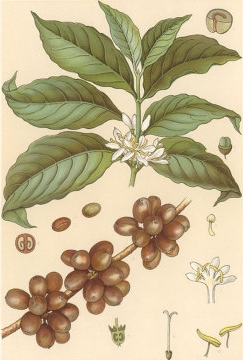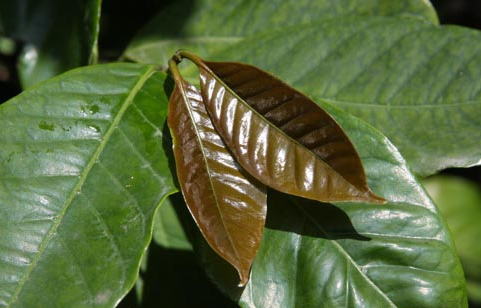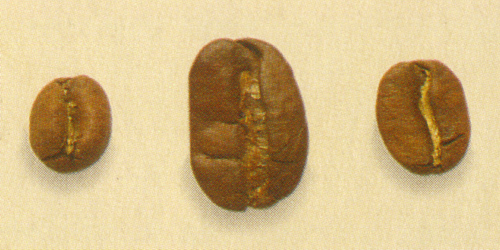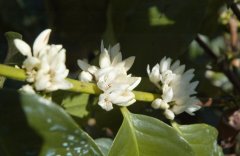Introduction to the types of Fine Coffee
Taxonomically, coffee belongs to the Genus Coffea of the Rubiaceae family, under which there are at least 100 coffee varieties.
The following has been mentioned in the "Healthy Life" post "Love Boutique Coffee": The more common coffee has Arabica (Arabica, elegant flavor, is the main force of boutique coffee) and Robusta (Robusta, or thick beans, coarse flavor, high caffeine content, not boutique coffee) two major types.
In addition to these two species, there are two small species, Liberica(tall tree, mainly grown in Malaysia and West Africa) and Excelsa; but these two small species are very rare in the market (even the official Chinese translation has not been found).
Arabica also has many subspecies, all derived from the earliest Ethiopian Typica and Yemeni bourbon transplanted into Central and South America or Asia; the variety is numerous and numerous. But fine coffee mainly refers to carefully cultivated high-altitude Arabica, and there are not many varieties. The broad categories are listed below.

Ancient Protospecies:
Typica: The oldest indigenous variety of Ethiopia, from which all Arabica is derived. Tiebika has bronze top leaves, oval or thin pointed bean body, elegant flavor, weak constitution, poor disease resistance and low fruit yield. Jamaica Blue Mountain, Sumatra Mantning, Hawaii Kona and other excellent estate beans belong to Tibika.
Bourbon: Early (coffee prehistoric) variant of tibeka transplanted to Yemen, bean-shaped from thin pointed to rounded. In 1715, France transplanted the round beans of Yemen mocha to Bourbon Island on the east coast of Africa (renamed Reunion after the French Revolution) before it was named Bourbon. Bourbon beans were introduced to Brazil and Central and South America in 1727, and Yemeni mocha was transplanted to St. Helena Island (where Napoleon was later imprisoned) in 1732. Bourbon is the winner of the American Fine Coffee Cup test.
One of the characteristics of Tibika is that the top leaves are bronze.

Gene mutation Bourbon Pointu: Discovered in Bourbon Island in 1810, the bean body has changed from round to pointed, with only half the caffeine content; but the quantity is small and weak, and it is extremely precious (mostly cultivated in the laboratory).
Maragogype (or Elephant Bean): The best-known variety of tibeka bean, first discovered in 1870 in the Maragogype bean-growing region of the northeastern Brazilian state of Bahia, the bean is at least three times larger than the average Arabica, hence the name. The flavor of elephant bean is bad at low altitude, but it is better at high altitude, with mild sour taste and sweet fragrance.
Geisha: A derivative of the Tibika family, Geisha was exported from the Geisha Mountains in southern Ethiopia in 1931, and after many countries became unknown, it was transplanted to Panama in the 1960s, and it began to win frequently in cup competitions in 2005.
Kenya "SL28" and "SL34": French and British missionaries and researchers in the early twentieth century in Kenya screening, breeding out of Bourbon lineages, a century has been adapted to Kenya's high concentration of phosphoric acid soil, breeding Kenya's characteristics of sour spirit; top Kenyan coffee are from these two varieties, but transplanted elsewhere is tasteless.
Bourbon Amarello (Yellow Bourbon): A variety of Bourbon endemic to the Brazilian state of Sao Paulo, whose coffee fruits do not turn red when ripe and are orange-yellow. Other local bourbon derivatives were later found to have yellowed skins.
Caturra: A single genetic variant of bourbon discovered in Brazil in the 1950s. Long energy and disease resistance are better than bourbon, and no shade trees are needed; flavor is equal to or slightly worse than bourbon.
Pacas: Bourbon variety found in El Salvador, 1935 El Salvador coffee farmers Pacas transplanted the name Bourbon, to 1956 found that the results are higher than other coffee trees of the same kind, please identify the genetic mutation after identification.
Villa Sarchi: Bourbon variety first discovered in Costa Rica in the 1960s, often appearing in cup test excellence lists in recent years.
From left to right: Kenya Round Bean, Elephant Bean, Kenya AA

Arabica intraspecific Hybrid Mundo Novo: A natural hybrid of Bourbon and Sumatra tibeka, first discovered in Brazil. High yield, disease and pest resistance, planted in Brazil in large quantities in the 1950s, known as the new hope of Brazil's coffee industry; but the trees are tall and difficult to harvest.
Catuai: A hybrid of New World and Kadura; short trees, wind-resistant, but with a more monotonous flavor.
Pacamara: A hybrid of Pacas and Maragogype, the bean is second only to the elephant bean. It is an excellent variety bred by El Salvador in the 1950s. In recent years, the cup test results are good.
Kent: A hybrid variety of iron pica discovered in India, with high yield and disease resistance, but without good cup test results.
Arabica-robust bean (Interspecific Hybrid)
Timor: Natural hybrid found in East Timor and having 44 chromosomes, closer to Arabica; but bland in flavor.
Catimor: In 1959, the Portugal interbred Brazilian cadura with timo to breed a disease-resistant catimo. However, the flavor is also poor, and it is an important variety of commercial beans at present.
Icatu: Brazilian multi-generation hybrid improved variety, has been in Brazil's "extraordinary cup" top ten.
Ruiru 11: A hybrid variety developed in Kenya in 1985 that emphasizes yield rather than quality.
Arabica and stout bean hybrids have so far failed to qualify as specialty coffee; so many specialty fresh roast coffee vendors, such as fresh, do not have them. However, many even imported specialty coffee suppliers, but some of the hybrid beans into the blend (Blend) to reduce costs.
In addition, from the above-mentioned gene mutations (whether natural or scientific research products), their flavors have a great relationship with specific geographical conditions. Even within the same country, coffee beans produced on different plantations can vary significantly. For example: Jamaica national treasure Wallenford Manor Blue Mountain, more than twice as expensive as Jamaica super high mountain Blue Mountain.
Important Notice :
前街咖啡 FrontStreet Coffee has moved to new addredd:
FrontStreet Coffee Address: 315,Donghua East Road,GuangZhou
Tel:020 38364473
- Prev

Boutique coffee knowledge where does the real aroma of coffee come from?
In a coffee obsession like mine, there is no smell comparable to the smell in the coffee field during the flowering period. The first flowering period of the coffee tree is about three years. The white flowers are five-petal tube-shaped flowers, with a faint fragrance of jasmine, and the inflorescences are arranged in dense clusters. It will wither after two or three days of flowering and begin to bear fruit after a few months. In Yunnan, this is the right time.
- Next

Fine coffee technology coffee grinding skills
The task of grinding roasted coffee beans into powder is called crushing, and the props for grinding coffee beans are called grinders. Beethoven counts sixty coffee beans in the grinder every morning, grinds them and then brews them. Grind the coffee and enjoy its aroma. And then experience the fun excitedly. According to its size, the grinding methods of coffee beans can be divided into three types: rough grinding, medium grinding and fine grinding.
Related
- Beginners will see the "Coffee pull flower" guide!
- What is the difference between ice blog purified milk and ordinary milk coffee?
- Why is the Philippines the largest producer of crops in Liberia?
- For coffee extraction, should the fine powder be retained?
- How does extracted espresso fill pressed powder? How much strength does it take to press the powder?
- How to make jasmine cold extract coffee? Is the jasmine + latte good?
- Will this little toy really make the coffee taste better? How does Lily Drip affect coffee extraction?
- Will the action of slapping the filter cup also affect coffee extraction?
- What's the difference between powder-to-water ratio and powder-to-liquid ratio?
- What is the Ethiopian local species? What does it have to do with Heirloom native species?

